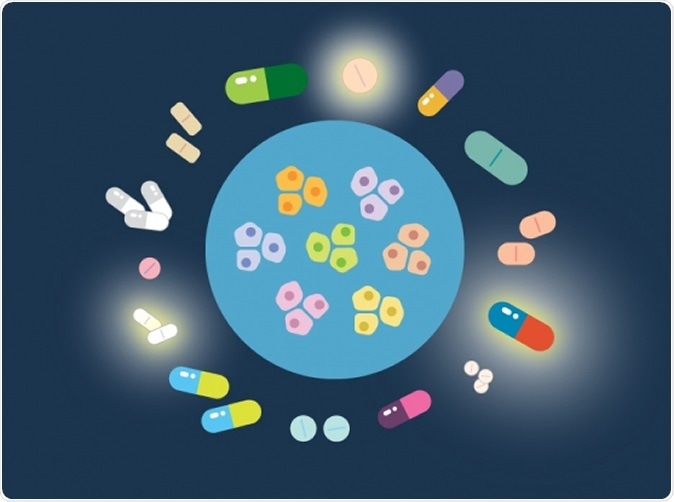It turns out that in the rush to invent new drugs to treat cancers, scientists may have overlooked some obvious possibilities of existing drugs currently being used for other diseases. A new study says that therapies for diabetes, inflammation and alcoholism, and even for dog arthritis, can also result in the successful killing of cancer cells in culture.
The study, published in the journal Nature Cancer, is based on the use of the drug library called the Broad’s Drug Repurposing Hub. Throughout the past, new indications for existing drugs have been discovered uncommonly, as for instance the discovery of the cardiovascular benefits of the nonsteroidal anti-inflammatory drug (NSAID) aspirin. The purpose behind the Repurposing Hub was to allow similar discoveries to be made without having to depend on pure chance, according to first author Steven Corsello who set it up.

Credit : Susanna Hamilton, Broad Communications
The study
The study is the largest of its kind to use this Hub, and it is also unique in that for the first time, this study was carried out over the whole range of drugs in the repository to assess their anti-cancer effects. The Hub contained over 4500 drugs at the time of the study, all of which were already being used, as well as other compounds that are already approved by the FDA or have passed safety tests in clinical trials.
The complete set of drugs and compounds was tested on about 580 cancer cell lines derived from human cancer cells, stored in the Broad’s Cancer Cell Line Encyclopedia (CCLE). The researchers assigned a DNA barcode to each of the cancer cell lines by their own method of molecular barcoding called PRISM. The idea was that this would let them test multiple cell lines in one dish, so as to accelerate the speed of testing.
The scientists added just one compound from the library to each cell dish and assessed the cancer cells to see how many had survived.
The findings
The results were striking: almost 50 of these compounds that were originally developed against cholesterol or to fight inflammation were active against cancer cells. Researcher Todd Golub says, “We thought we'd be lucky if we found even a single compound with anti-cancer properties, but we were surprised to find so many.”
Some of the drugs acted in surprising ways on the cancer cells to kill them. For instance, says Corsello, rather than blocking the actions or production of proteins like most current cancer drugs, some of these compounds did other things to block cancer cell metabolism. Several of them activated a protein rather than blocking it. Others facilitated a stable interaction between different types of proteins. One example is the interaction between the PDE3A protein and the SLFN12 protein, which has not been observed before to occur with any of these drugs as an anticancer effect.
Most of the newly discovered drugs acted through their effects on cell molecules that had not been known to be targeted by any drug until then. One instance is the drug tepoxalin, an anti-inflammatory that was switched from human use to the treatment of osteoarthritis in dogs. It was found to take out cancer cells that have abnormally high levels of the protein MDR1 via some unrecognized mechanism. This protein normally indicates that the cell will not respond to anticancer drugs.
In addition to detecting cell kill rate with each drug, the researchers looked at the genome of each cell line, including the percentage of mutations and the levels of methylated DNA, which is recorded in the CCLE. They found that they could predict the drug’s ability to wipe out the cell line based on genomic features.
An example of this is the drug Antabuse or disulfiram, used to treat alcoholism. The researchers found that in cells that harbored specific mutations that led to low levels of metallothionein proteins, Antabuse caused cell death. The same effect was observed with vanadium compounds meant to treat diabetes, which killed cancer cells with the molecule SLC26A2, which is a sulfate transporter.
Drug Repurposing Hub
Implications
The study thus identified non-cancer drugs with anticancer activity. It also showed that these drugs used hitherto unknown mechanisms to influence new cell targets. This reveals the potential of this approach to find new cancer drugs by adapting drugs used for other indications, as well as to use the novel mechanisms of action or cell targets to develop new drugs against cancer. Its approach, using cancer cell lines to screen for anticancer activity in terms of cell survival, is also easier to implement than the conventional high-throughput screening techniques.
The genomic associations could lead to their use as identifying features, or biomarkers, in future, to evaluate the benefit that a given patient may obtain from the use of the drug in question.
In addition, the researchers think they have obtained some leads on how the cells are killed by the drugs from the genomic markers. This will be the starting point of more advanced investigations, which could lead to the development of still more treatments.
The future
Their next agenda will include extending the study of the repurposing library to more cancer cell lines, as well as to extend the reach of the Hub by including more compounds that have been tested in humans. The data obtained from the study is available as an open-access file, which the team continues to sift through for more information on how these compounds act in this selective way on cancer cells but not healthy cells. Says Corsello, “This is a great initial dataset, but certainly there will be a great benefit to expanding this approach in the future.”
Journal reference:
Corsello, S.M., Nagari, R.T., Spangler, R.D. et al. Discovering the anticancer potential of non-oncology drugs by systematic viability profiling. Nat Cancer (2020) doi:10.1038/s43018-019-0018-6, https://www.nature.com/articles/s43018-019-0018-6